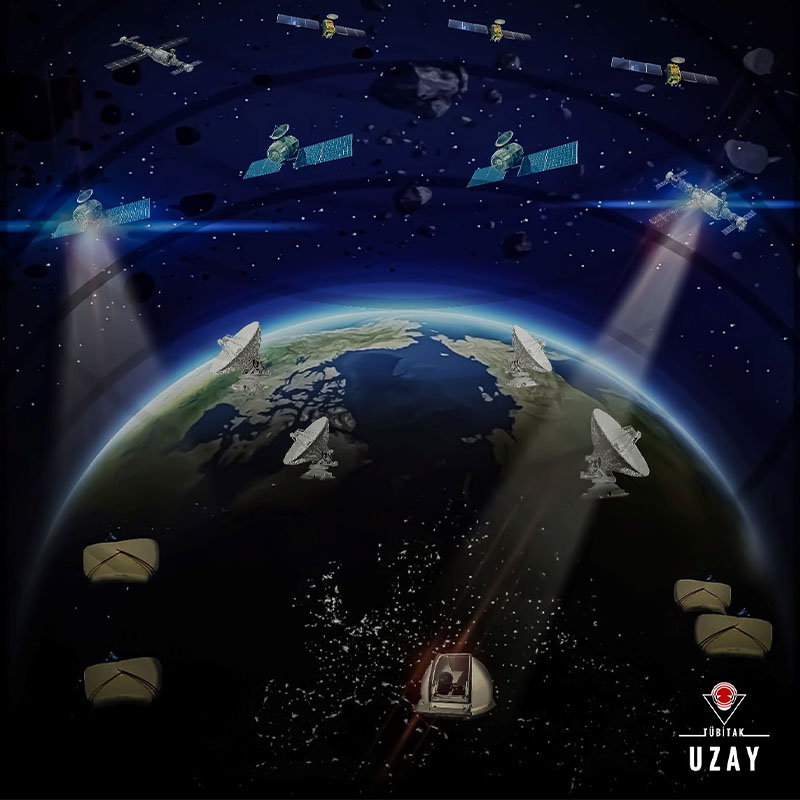UZAY
Leading Solutions in Space Situation Awareness
Leading Solutions in Space Situation Awareness
(Satellite Management Equipment)
TÜBİTAK UZAY provides pioneering solutions in the field of Space Situation Awareness (SSA) by demonstrating a comprehensive competence in various space projects. SSA system engineering provides tracking and management of space objects, while astrodynamic analyses perform trajectory calculations and maneuver planning. Mission planning services and mission simulations are used to effectively manage space missions.
Expertise in the design, selection and integration of passive and active sensors enables the optimization of various spacecraft and systems. There are also capabilities to develop robotic systems for automation and precision operations in space missions. Data processing technologies are used to analyze and interpret data obtained from space.
Big data, database and user interface management enable the processing of large amounts of data in space projects and the development of interfaces that meet the needs of users.
Space Situation Awareness (SSA) is of utmost importance in today's space exploration and operations. TÜBİTAK UZAY offers a wide range of services to increase the efficiency and safety of space operations:
- Observing and tracking celestial bodies with different sensors
- Data processing, parsing and filtering
- Data fusion
- Celestial body detection and matching
- Celestial orbit detection and refinement
- Mission planning and analysis
- Maneuver detection, collision warning
- Launch and reentry monitoring
- Celestial body characterization
- Satellite and space junk catalog
- Big data management

SSA Features
Main Features
Celestial Observation and Tracking with Different Sensors
Different systems are used to accurately and continuously observe celestial bodies. These sensors provide real-time monitoring of satellites and space debris in Earth orbit.
Data Processing, Parsing and Filtering
Processing, parsing and filtering the collected data is essential to extract important data. Sophisticated algorithms and artificial intelligence technologies analyze large datasets, weeding out redundant data and uncovering important information.
Data Fusion
Combining data collected from different sources provides a better understanding of the state of space. Data fusion technology has the ability to produce more accurate and reliable results by combining data from various sensors. This method is used to better understand and monitor events occurring in space.
Celestial Body Detection and Matching
The detection and tracking of orbiting objects is as important as their identification. Using advanced detection and matching algorithms, celestial bodies are accurately tracked and identified. This enables more effective management of satellites and other objects operating in space.
Celestial Orbit Detection and Enhancement
To reduce collision risks and plan missions, the orbits of celestial bodies need to be precisely determined and, where necessary, improved. Trajectory detection and refinement is achieved by continuously updating and analyzing available trajectory data.
Mission Planning and Analysis
The success of operations is related to planning and analyzing space missions. Mission planning services ensure optimal management of missions and spacecraft.
Maneuver Detection and Collision Warning
The safety of spacecraft can be ensured by preventing potential collisions and detecting maneuvers. Collision warning systems detect potential hazards and allow for rapid intervention.
Launch and Atmosphere Entry Monitoring
Successful operations depend on carefully monitoring the launch and reentry of spacecraft. Precise control of these processes helps ensure smooth operations.
Celestial Body Characterization
The physical and chemical properties of celestial bodies provide important information for space exploration. Understanding the structure and behavior of different celestial bodies is a result of characterization studies.
Satellite and Space Junk Catalog
The management of space traffic requires a comprehensive cataloging of active satellites and space junk. Through cataloging, all space objects can be tracked and managed.
Big Data Management
Large volumes of data from space need to be managed effectively. Big data management solutions optimize the storage, processing and analysis of data, enabling rapid return to the user.





